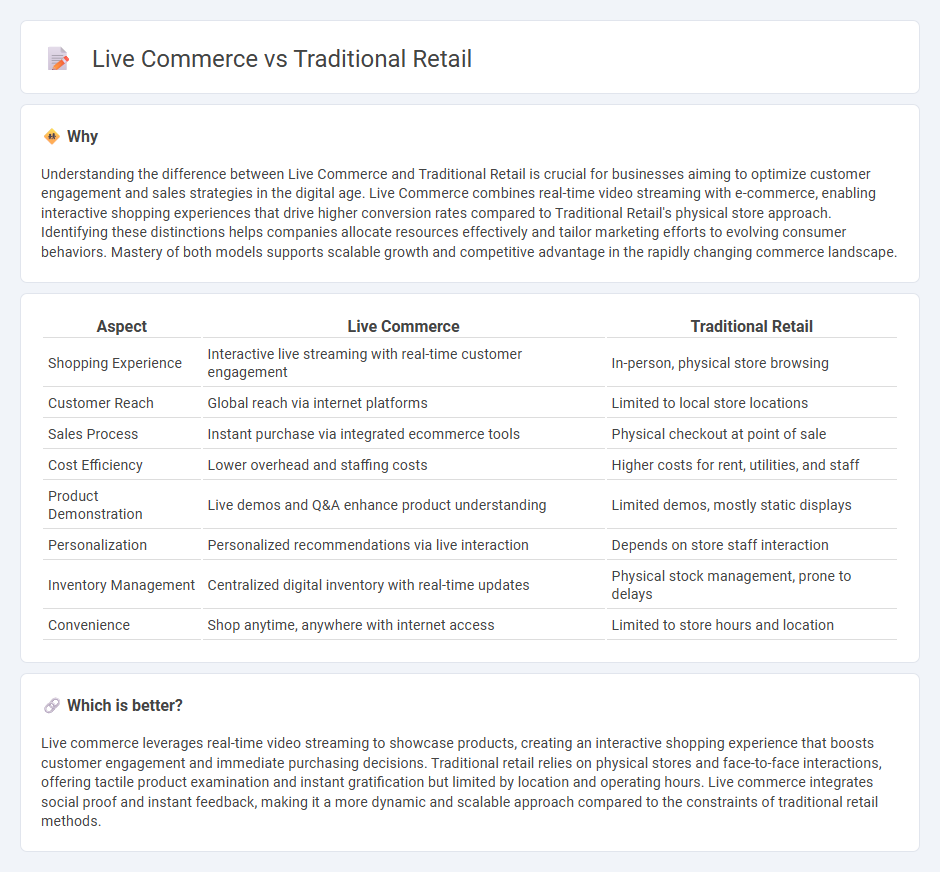
Live commerce integrates real-time video streaming with online shopping, allowing consumers to interact directly with hosts and make instant purchases, enhancing engagement and convenience. Traditional retail relies on physical storefronts where customers browse products in person, providing tactile experiences and immediate ownership. Explore the evolving dynamics between live commerce and traditional retail to understand their impacts on modern consumer behavior.
Why it is important
Understanding the difference between Live Commerce and Traditional Retail is crucial for businesses aiming to optimize customer engagement and sales strategies in the digital age. Live Commerce combines real-time video streaming with e-commerce, enabling interactive shopping experiences that drive higher conversion rates compared to Traditional Retail's physical store approach. Identifying these distinctions helps companies allocate resources effectively and tailor marketing efforts to evolving consumer behaviors. Mastery of both models supports scalable growth and competitive advantage in the rapidly changing commerce landscape.
Comparison Table
| Aspect | Live Commerce | Traditional Retail |
|---|---|---|
| Shopping Experience | Interactive live streaming with real-time customer engagement | In-person, physical store browsing |
| Customer Reach | Global reach via internet platforms | Limited to local store locations |
| Sales Process | Instant purchase via integrated ecommerce tools | Physical checkout at point of sale |
| Cost Efficiency | Lower overhead and staffing costs | Higher costs for rent, utilities, and staff |
| Product Demonstration | Live demos and Q&A enhance product understanding | Limited demos, mostly static displays |
| Personalization | Personalized recommendations via live interaction | Depends on store staff interaction |
| Inventory Management | Centralized digital inventory with real-time updates | Physical stock management, prone to delays |
| Convenience | Shop anytime, anywhere with internet access | Limited to store hours and location |
Which is better?
Live commerce leverages real-time video streaming to showcase products, creating an interactive shopping experience that boosts customer engagement and immediate purchasing decisions. Traditional retail relies on physical stores and face-to-face interactions, offering tactile product examination and instant gratification but limited by location and operating hours. Live commerce integrates social proof and instant feedback, making it a more dynamic and scalable approach compared to the constraints of traditional retail methods.
Connection
Live commerce merges real-time interactive video streaming with e-commerce, creating an engaging shopping experience that complements traditional retail by driving online traffic and expanding customer reach. Traditional retail benefits from live commerce through enhanced brand visibility and instant consumer feedback, bridging the gap between physical stores and digital platforms. The integration of live commerce into retail strategies boosts sales conversion rates and fosters deeper customer loyalty through personalized engagement.
Key Terms
Brick-and-mortar
Brick-and-mortar stores provide tactile shopping experiences and immediate product access, contrasting with live commerce's interactive digital platform that leverages real-time engagement and influencer marketing. Live commerce enhances customer interaction through live demonstrations and instant purchasing options, while traditional retail relies on physical presence and direct customer service. Explore how integrating these approaches can elevate your retail strategy and drive sales growth.
Real-time interaction
Traditional retail offers a fixed shopping experience with limited engagement, relying primarily on in-store displays and static product information. Live commerce transforms this dynamic by enabling real-time interaction between sellers and buyers through live video streaming, fostering instant feedback and personalized purchasing decisions. Discover how this shift impacts consumer behavior and boosts sales in the evolving retail landscape.
Shoppable livestreams
Shoppable livestreams revolutionize traditional retail by merging real-time interaction with instant purchasing, enhancing customer engagement and boosting conversion rates. Brands leveraging live commerce see a significant increase in average order value and a more personalized shopping experience compared to conventional e-commerce. Explore how integrating shoppable livestreams can transform your retail strategy and drive sales growth.
Source and External Links
Direct to Customer vs. Traditional Retail Business Model - The traditional retail business model involves selling products through intermediaries such as wholesalers and retailers, featuring physical stores, inventory management, and limited direct consumer interaction, leveraging established retail partnerships to optimize distribution and customer acquisition.
Retail vs. E-commerce: What's the Difference? | Indeed.com - Traditional retail refers to selling goods directly to consumers via physical stores, allowing in-person customer service, immediate product testing, and no shipping costs, offering a personal shopping experience.
The Fall of Traditional Retail Commerce | Nexcess - Traditional retail evolved from small mom-and-pop shops to department stores, shopping malls, and big-box stores like Walmart before the rise of e-commerce shifted consumer behavior towards online shopping.
 dowidth.com
dowidth.com